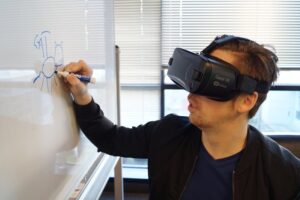One of the world’s oldest sports is embracing cutting-edge technology. During the 2022 World Cup in Qatar, FIFA, the governing body for international football, debuted a new technology: micro-chipped balls.
Fans at the world’s most popular sporting event noticed soccer balls being charged on the sidelines before games and took to social media in search of answers.
As it turns out, FIFA is using this year’s World Cup to implement a technology that tracks positional data and nuanced movement through sensors in Adidas’ official tournament soccer balls.
Future Tech in the Beautiful Game
Adidas partnered with KINXON, a major player in the sports technology world, to create a ball designed to house two sensors at the central interior point of the ball and keep it secure in a consistent location.
KINEXION spent six years developing and testing the sensors, which combined weigh just half an ounce, before they were approved by FIFA.
The first sensor uses ultra-wideband (UWB) frequencies that are more accurate than GPS or Bluetooth. This helps give precise data on where the ball is at any time and transmit that data in real-time.
The second sensor is an inertial measurement unit (IMU) sensor, which gives a granular look at how the ball moves in space.
Every time the ball is kicked, the sensors pick up data at 500 frames per second. That information is then instantly transmitted to the local positioning system (LPS) installed around the field.
“While the ultra-wideband helps me to have the position of an object, the IMU gives me the granular movement in three dimensions,” said Maximillian Schmidt, co-founder and managing director of KINEXON.
NEW: Semi-automated offside technology to be used at FIFA World Cup 2022. Full details on @FIFAcom. Here’s how it works 👇 pic.twitter.com/qrDzjsXxph
— Bryan Swanson (@fifa_bryan) July 1, 2022
With a Little Help from AI
The purpose of the sensors is severalfold. First, the data collected helps the referee and officials in the control room when reviewing offside calls.
FIFA’s application of this technology at the 2022 World Cup is being termed a “semi-automated offside” program — one that’s largely run by AI features, but retains a vital element of human confirmation.
The additional confirmation provided by the sensors is intended to act as a complement to the VAR (video-assisted referee) system already used in most professional domestic and international leagues and tournaments.
The new technology also provides critical data to managers, training staff, and players.
KINEXION-equipped balls were first tested in a 2022 Liga Portugal relegation match, in which the sensors were also attached to players’ jerseys.
These allowed them to collect over 300 metrics spanning everything from ball possession time to dribbling speed to ball gains/losses. In addition to being a dream come true for any statistics-obsessed fan, the data can be used by clubs to finetune tactics.
“We can use that information in real-time to tell new stories,” said Schmidt. “[We can use] them to create virtual worlds, augmented overlays, insights on [the] performance of players.”











